First Aid Tips
First Aid Tips
First aid is the provision of initial care for an illness or injury. It is usually performed by non-expert, but trained personnel to a sick or injured person until definitive medical treatment can be accessed. Certain self-limiting illnesses or minor injuries may not require further medical care past the first aid intervention. It generally consists of a series of simple and in some cases, potentially life-saving techniques that an individual can be trained to perform with minimal equipment.
Purpose of First Aid
- To save life
- To prevent further injury
- To preserve vitality and resistance to infection
First Aid Kit
Every office, factory, home and school should have an accessible first-aid box. It is readily available in shops but you can use a tin or card board box at home as your first aid box. Following are the common stuff you should have in your first aid box.
|
|
|
Non-prescription drugs |
|
|
|
Keep your first aid kit where it is easily accessible. Replace drugs whenever they reach the expiry date.
Basic tips for illness/injury
- Make sure your household has a first aid kit. It should have basic medicines which are readily accessible
- Keep your first aid kit, all medications, including non-prescription drugs out of children's reach.
- Before assisting a victim, protect yourself first. Assess the scene and determine the prevalent hazards, if any. Whenever possible, wear gloves to protect yourself from blood and other bodily fluids.
- When an emergency occurs, make sure the tongue does not block the victim's airway and that the mouth is free of any secretions and foreign objects. It's important that the person is breathing freely. And if not, administer artificial respiration promptly.
- See that the victim has a pulse and good blood circulation as you check for signs of bleeding. Act fast if the victim is bleeding severely, swallowed poison or his heart or breathing has stopped. Remember every second counts.
- It's vitally important not to move a person with serious neck or back injuries unless you have to save him from further danger. If he has vomited and there is no danger that his neck is broken, turn him aside to prevent choking and keep him warm by covering him with blankets or coats.
- Have someone call for medical assistance while you apply first aid. The person who calls the doctor should explain the nature of the emergency and ask for advice on what should be done by the time the ambulance arrives.
- Be calm and give psychological support to the patient.
- Don't give fluids to an unconscious or semi conscious person. Fluids may enter his windpipe and cause suffocation. Don't try to arouse an unconscious person by slapping or shaking.
- Look for an emergency medical identification card to find out if the victim is allergic to medicines or has any serious health problems that require special care.
Cuts and Abrasions
Cuts
- Cleanse area thoroughly with soap and warm water, carefully washing away any dirt.
- Apply direct pressure to wound until bleeding stops.
- Put sterile bandage on wound.
- If cut is deep, get to a doctor as quickly as possible.
Abrasions /Scratches
- Wash thoroughly with soap and warm water.
- If it bleeds or oozes, bandage it to protect it from infection.
Signs of infected wound
- Swelling
- Redness
- Pain
- May cause fever
- Presence of pus
Choking
If a person is choking, you should not interfere as long as he is coughing.
If coughing does not dislodge the object from the trachea and the victim is breathing with extreme difficulty, or if he turns a bluish color and appears to be choking but is unable to cough or speak, quickly ask, "Are you choking?" A choking victim can nod his head "yes," but will be unable to talk. It is important to ask this question because a person suffering from a heart attack will have similar symptoms, but he will be able to talk.
Use the Abdominal Thrust only in an actual emergency
- Stand behind him with your arms around his waist.
- Place one fist, with the knuckle of the thumb against the victim's midsection, slightly above the navel but well below the breastbone.
- Hold your fist firmly with the other hand and pull both hands sharply toward you with an upward-and-inward jab.
- This procedure should be administered continually until either the object is forced out or the victim becomes unconscious.
Take the patient to the doctor immediately if you're not comfortable handling the emergency
Fainting
Before losing consciousness, the victim may complain of
- Light headedness
- Weakness
- Nausea
- Skin may be pale and clammy
If a person begins to feel faint, he should...
- Lean forward
- Lower head toward knees
As the head is lowered below the heart, blood will flow to the brain.
When the victim becomes unconscious
- Keep the victim lying down with head lowered and legs elevated
- Loosen any tight clothing
- Apply cool, damp cloths to face and neck
In most cases, the victim will regain consciousness shortly after being placed in this position. Ensure that the patient has regained full consciousness by asking him questions of his identity.
It is always best to consult a doctor
Convulsions
A convulsion (violent, involuntary contraction or muscle spasm) can be caused by epilepsy or sudden illness. It is dangerous if the victim stops breathing. In such cases, it is recommended to seek doctor's assistance.
Symptoms
- Muscles become stiff and hard, followed by jerking movements
- The patient may bite his tongue or stop breathing
- Face and lips may turn a bluish color
- May salivate excessively or foam at the mouth
Tips for action
- Clear all objects away from the victim and place something soft under the head
- Do not place anything between the teeth or in the patient's mouth
- Do not give the victim any liquids
- If the victim stops breathing, check to see that the airway is open and begin rescue
- Stay calm and keep the victim comfortable until help arrives.
- Most convulsions are followed by a period of unconsciousness or another convulsion
Take the patient to the doctor at the earliest
Heatstroke
- Cool the body of a heatstroke victim immediately
- If possible, put him in cool water; wrap him in cool wet clothes; or sponge his skin with cool water, rubbing ice, or cold packs.
- Once the victim's temperature drops to about 101 F, lay him in the recovery position in a cool room.
- If the temperature begins to rise again, repeat the cooling process
- If he/she is able to drink, give him/her some water.
- Do not give any kind of medication
- Seek medical attention
Bleeding
Bleeding is the loss of blood from the circulatory system. Bleeding can occur internally, where blood leaks from blood vessels inside the body or externally, either through a natural opening such as the vagina, mouth, nose, or through a break in the skin.
If foreign body in the wound
This may be, for instance, a piece of glass, wood or metal.
Apply pressure with your fingers or thumbs along the edge of the wound, leaving the foreign body in its place inside the wound. Do not remove the foreign body.
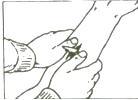
Apply dressing along the edge of the wound and hold them in place with a tight bandage, still leaving the foreign body in place
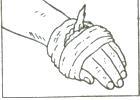
If the wound is in an arm or leg and the bleeding profuse, lay the causality down and raise the arm or leg above the level of the heart.
Arrange for an ambulance, or take the causality to hospital by car.
Coughing Blood
Coughing blood (i.e. a small cupful or more) is not a common occurrence but when it does occur it is very frightening for both the patient and relatives. It is usually the result of a disease of the lungs, such as a lung cancer or severe tuberculosis, or some form of perforating injury to the lungs.
Care
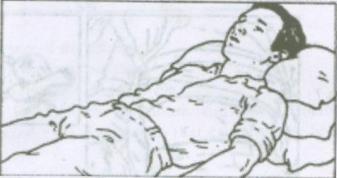
- Lay the casualty down with the head and shoulders slightly raised and inclined towards the injured side.
- Do not give any food or liquid by mouth
If bleeding from the lungs is caused by a wound to the chest, then a firm padded addressing covered with a piece of polythene must be applied over the wound and secured as firmly as possible, to prevent air being sucked into the wound and so into the chest cavity, thereby causing other possible complications
Send for your doctor immediately or arrange for an ambulance to take the causality to hospital.
Vomiting Blood from the Stomach
This is usually due to a stomach ulcer that has been bleeding. When the stomach has filled with blood, it suddenly contracts and the casualty vomits up all the blood may amount to as much a liter or more.
Care
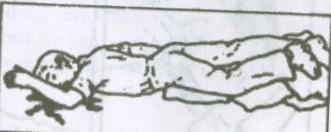
- Lay the casualty down with the feet and legs raised higher than the body
- Keep the casualty at a reasonable temperature. Do not overheat by applying too many blankets or hot water bottles – keep the casualty just warm, and do not let him shiver with cold
- Do not give any food or liquid by mouth
- The mouth may be washed out with water, but none must be swallowed
- Send immediately for a doctor, or arrange for an ambulance to take the casualty to hospital
If the casualty becomes unconscious, he must immediately be turned on his side in the Recovery Position, but still keeping the feet and legs raised
Unconsciousness
The loss of consciousness is always a serious sign. Unconsciousness is described as the state in which the human being will not respond in any way to shaking, shouting or pinching. If a person who appears unconscious recovers and ‘comes to’ quickly when shaken, spoken to sharply, or pinched - instantly knows where he is and who he is - then that person was asleep and not unconscious. In casualties who are only just unconscious, the eyes may be moving about and when a bright light is shone into them the pupil’s contract. In people who are deeply unconscious, however, the eyes may be fixed as if looking straight ahead with the pupils dilated (bigger than normal); the pupils will not contract when a light is shone into them. In these conditions—with the pupils dilated and the eyes fixed in one position --- it usually means that the casualty is near to death. When you find a person apparently unconscious, apply the Shake, Shout and Pinch routine. If there is no response, he is unconscious.
The loss of consciousness is always a serious sign. Unconsciousness is described as the state in which the human being will not respond in any way to shaking, shouting or pinching. If a person who appears unconscious recovers and ‘comes to’ quickly when shaken, spoken to sharply, or pinched - instantly knows where he is and who he is - then that person was asleep and not unconscious. In casualties who are only just unconscious, the eyes may be moving about and when a bright light is shone into them the pupil’s contract. In people who are deeply unconscious, however, the eyes may be fixed as if looking straight ahead with the pupils dilated (bigger than normal); the pupils will not contract when a light is shone into them. In these conditions—with the pupils dilated and the eyes fixed in one position --- it usually means that the casualty is near to death. When you find a person apparently unconscious, apply the Shake, Shout and Pinch routine. If there is no response, he is unconscious.
Care
- Place the casualty in the Recovery Position in the following manner: turn him onto his back
- Tuck his left arm under the left buttock
- Place the right arm above the head
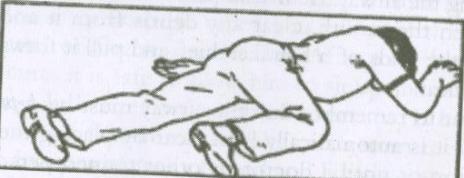
- Pull the body over on top of the left side
- Bend the right leg up to the bent position
- Bend the right arm into the bent position
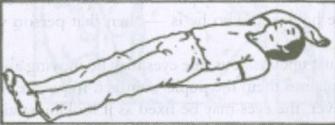
- Clear away anything loose from the mouth and throat, including dentures, thus producing a clear airway so that casualty may breathe easily
- Ease the left arm out behind the body
- Now lift the head upwards and backwards to ensure that the airway is clear
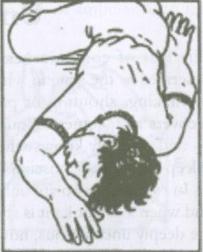
This is the left-side Recovery Position, but it may be more convenient to turn the casualty into the right-side recovery Position, in which case carry out the above routine substituting right for left and vice versa. In cases where it is impossible to turn the casualty into the Recovery Position owing to the presence of other injuries, or his being trapped, then the maintenance of a clear airway is carried out by placing two fingers behind the angle of the jaw on both sides and pushing the jaw forward towards the nose. This will force the tongue forward and away from the back of the throat, so clearing the airway. If this simple procedure should fail to clear the airway, and then open the mouth, clear any debris from it and then hold the tongue between the folds of a handkerchief and pull it forwards. The airway should then be clear. It is important to remember that the airway must be kept clear in one of these ways until it is automatically kept clear by placing the casualty in the Recovery Position or until a doctor or other trained person has passed a special type of breathing tube. The untrained person attempting to pass a tube may do more harm than good to the casualty.
- Do not give any food or liquid by mouth, as this will make the casualty choke and block the airway so that he cannot breathe
- Send for a doctor or call for an ambulance to take the casualty to hospital
- Whilst awaiting the arrival of the doctor or ambulance you must not only maintain the clear airway, but treat any other injuries the casualty may have sustained.
If the casualty appears dead, i.e. if the breathing and heart appear to have just stopped, then the Kiss of Life and heart massage must be started immediately. A doctor or ambulance must also be summoned as soon as possible. If the casualty is stiff from having died some time previously then leave the casualty in the position in which you find him and call a doctor and, where appropriate, the police.
Causes of unconsciousness
Fainting, Head injury, stroke, Epilepsy – major fits or convulsions, Minor fits, Heart attacks, Diabetes, Drugs, Drink, Severe bleeding, Acute and severe allergy, Electric shock, Drowning, Gas poisoning.
Electric shock & Drowning
Electric shock
This is usually easy to identify as the casualty will be lying unconscious near an electrical appliance or cable.
Treatment
- Before touching the casualty remember to switch off the electrical supply
- If the casualty is breathing, turn him into the Recovery Position
- If the casualty has stopped breathing, you must start the Kiss of Life and heart message immediately
- Send for a doctor or ambulance
Drowning
Treatment
- Clear the airway and determine whether causality is breathing and the heart pumping
- If the heart and breathing have stopped, then you immediately start the Kiss of life an heart massage
- If the causality is just unconscious, then once removed from water, he should be placed in the Recovery Position
- A doctor or an ambulance should be sent for immediately
Poisons
Poisons are substances or gases which when taken into the body in sufficient quantity will harm or destroy life. They can enter the body in three ways:
- Through the lungs
- Through the skin.
- By mouth.
Through the lungs
Poisoning through the lungs is dealt with under Breathing. Here then, we deal only with poisons that enter the body through the skin or by the mouth, whether accidentally or intentionally. Poisons which arise from contact come from certain horticultural and agricultural pesticides, and treatment for these conditions has been included. Most poisoning is accidental, and it is vital to take sensible Precautions against accidents.
Some important don’ts

- Never leave tablets or medicines within reach of children. Keep them in a locked cabinet, well out of reach (e.g. on top of a wardrobe)
- Never store tablets or medicines for long periods. They deteriorate and any surplus at the end of a course of treatment should be returned to the supplier (chemist or doctor) or flushed down the lavatory
- Never take drugs in the dark--- always read the label before taking or giving medicine.
- Never pour harmful liquids into lemonade or other drink bottles. Children will recognize the bottle and drink the contents
- Never keep domestic cleaners and detergents under the sink where toddlers can find them. (By the way, bleach and lavatory cleaners when mixed together do not produce a cleaner lavatory, but do produce a toxic gas which if inhaled is poisonous.)
- Never make a casualty vomit: never give large quantities of salt water
- Never give anything by mouth (unless the mouth is burnt and the casualty is conscious)
- Never attempt to give anything by mouth if casualty is unconscious
- Never wait for a casualty who has swallowed a petroleum preparation to vomit: casualty should be put in the Recovery Position from the beginning, with head lower than heart
- Never give or take any tablets, especially sleeping tablets, with alcohol--- the combination may be fatal
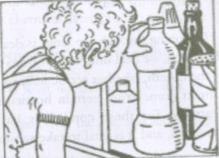
Common poisons
A few of more common poisons encountered in everyday life are illustrated. They are:
- Berries and seeds
- Fungi: toadstools
- Decomposing food
- Strong chemicals: paraffin, petrol bleaches, weed killers, chemical fertilizers
- Medicines: aspirin, sleeping tablets, tranquilizers, iron tablets
- Animal bait: rat and mouse poisons
- Alcohol
- Green potatoes. (It is not generally appreciated how dangerous green potatoes can be. They can cause colic, vomiting and eventually diarrhea, possibly followed by collapse.)
General Treatment
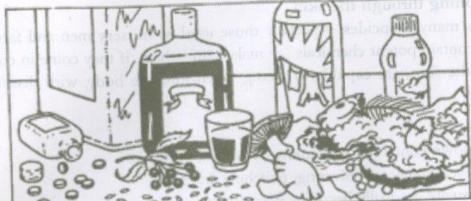
- The casualty may be conscious or unconscious, and if the former, may be able to help somewhat with your task.
- While casualty is conscious try to discover what has been swallowed, how much, and when
- If there are any tablets, empty bottles or cartons near the casualty, keep them for examination in hospital. This may help to identify the poison swallowed
- Examine the casualty’s mouth. If there is evidence of burning and the casualty can swallow give him as much milk or water as he can drink
- Should the casualty vomit--- catch the vomit in a dish or polythene bag and keep for examination in hospital. Again it may help in identifying the poison swallowed
- Get the casualty to hospital as quickly as possible. If the casualty is unconscious or becomes unconscious while in your care:
Poisoning through the skin
Today many pesticides, especially those used by nursery men and farmers, may contain potent chemicals (eg malathion) which, if they come in contact with the skin, are capable of being taken into the body, with disastrous results.
Clues
- Known contact or contamination with a pesticide
- Development of shivering, twitching and fits
- Casualty gradually becomes unconscious
Care
- Wash the contaminated area thoroughly with cold water
- Carefully remove any contaminated clothing, taking care not to touch the chemical yourself.
- Reassure the casualty, lie him down and encourage him to stay still and quiet
- Arrange for transfer to hospital as soon as possible
- Keep the casualty cool; apply cold pad to the forehead and sponge back of neck, spine and body with cold water
- Encourage casualty to drink as much cool fluid as possible
- Watch for twitching and fits developing
- If casualty becomes unconscious, check breathing and place casualty in the Recovery Position
- Always keep the poison container. It may have notes for treatment, but it is also important for your doctor to see it
Source: Portal Content Team
Last Modified : 2/21/2020
This topic provides information about Basics of Fi...
Ministry of Education has issued guidelines regard...
